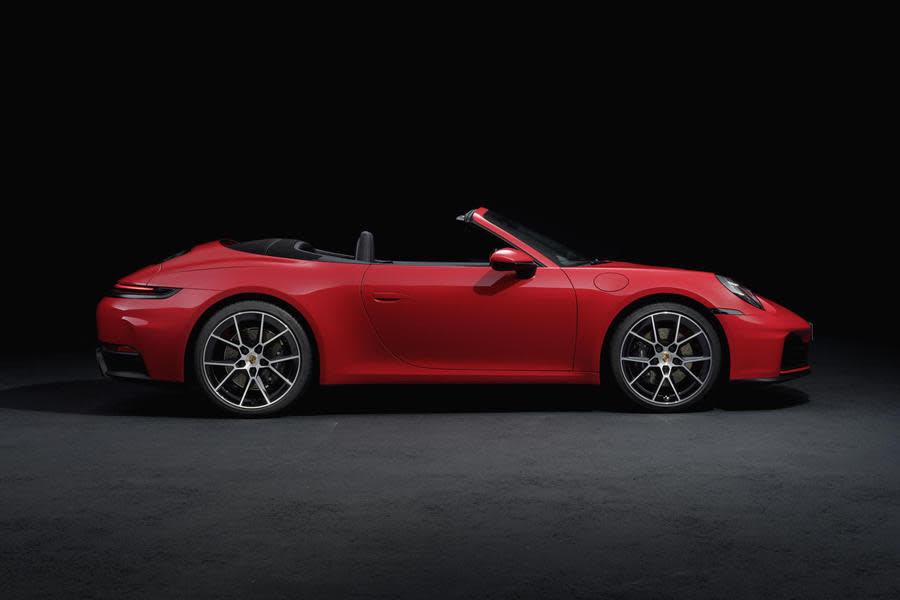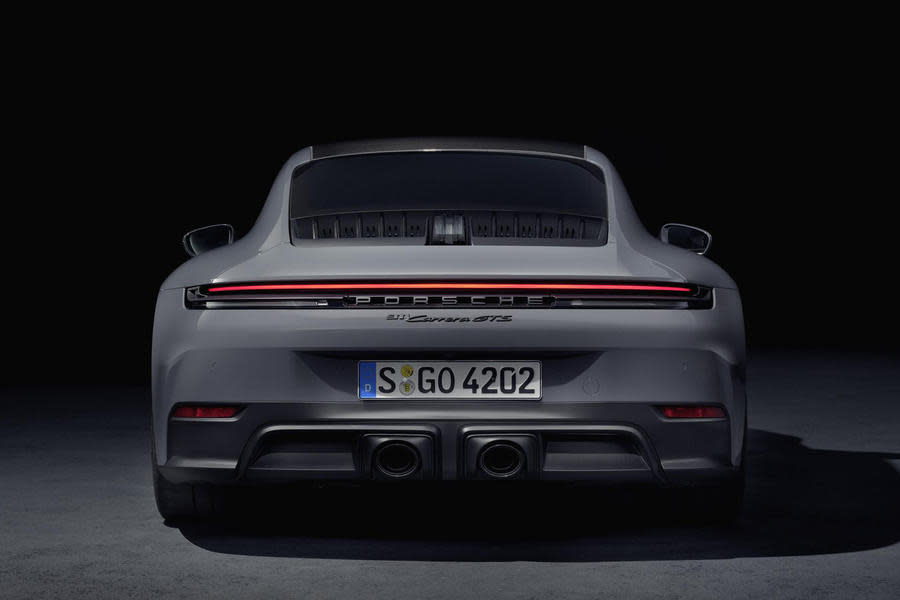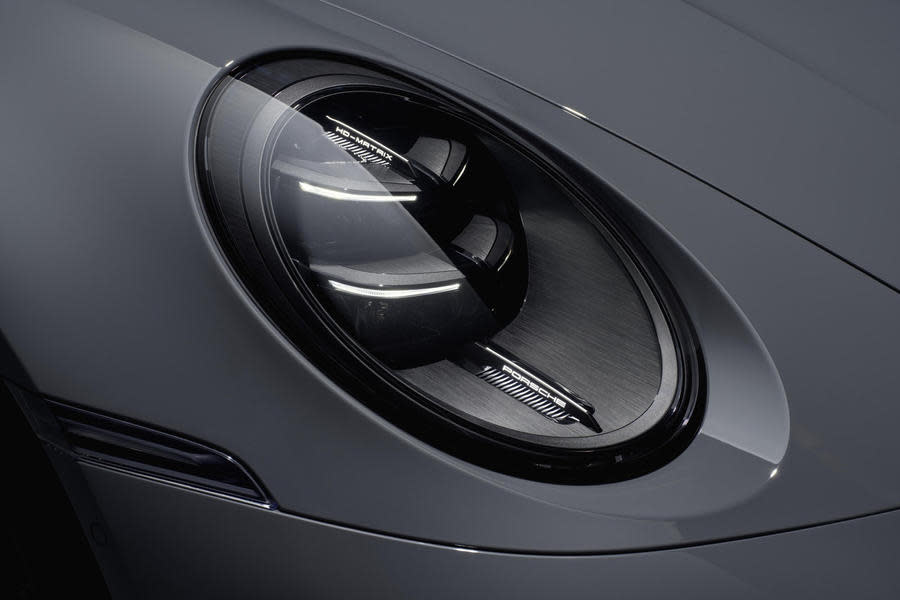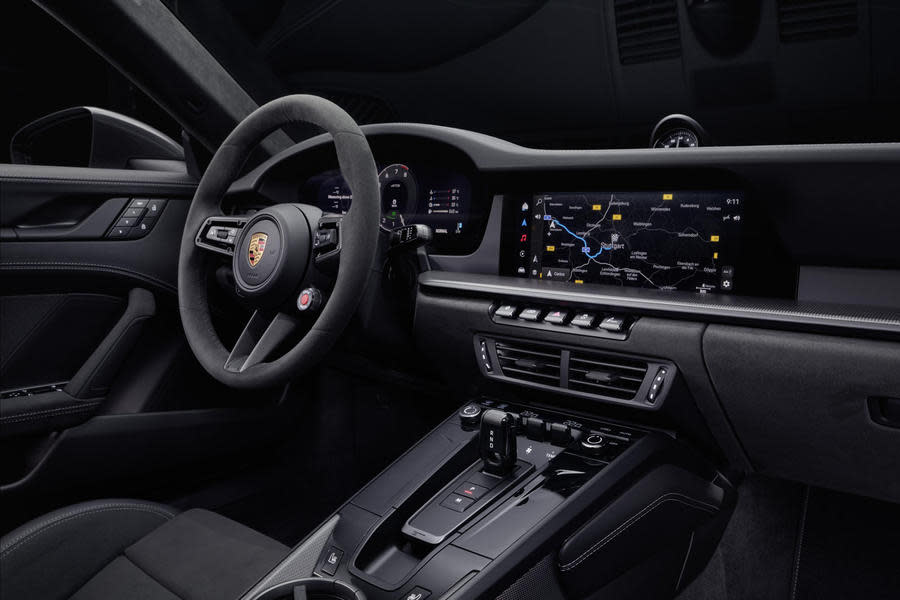Porsche 911 GTS goes hybrid for 534bhp and blistering track pace

Porsche claims 0-62mph in 3.0sec – 0.4sec quicker than the previous GTS
Porsche has electrified the 911 with a new hybrid flat six developed with learnings from the Le Mans-winning 919 race car.
The new T-Hybrid petrol-electric system is the headline addition for the facelifted seventh-generation 911, which will go on UK sale in September. The set-up features an all-new turbocharged 3.6-litre six-cylinder boxer engine, a gearbox-mounted electric motor and a compact liquid-cooled lithium ion battery.
Together, they provide the restyled rear-wheel-drive 911 GTS – which sits beneath the hardcore Turbo and GT3 and will be the first model to receive the drivetrain – with 534bhp and up to 450lb ft. Those outputs represent increases of 60bhp and 30lb ft over the previous model, which used a twin-turbo 3.0-litre six-cylinder.
Porsche claims a 0.4sec reduction in the 0-62mph time, at 3.0sec. It also quotes 0-100mph in 6.8sec (0.9sec quicker than before) and 0-124mph in 10.5sec (1.1sec quicker), along with an incremental 1mph increase in top speed to 194mph.

The improvements come despite a 50kg rise in kerb weight for the hybridised GTS, at 1595kg. Some 27kg of that is contributed by the battery, but because it sits up front, it is claimed to subtly improve the weight distribution of the new 911, giving a ratio of roughly 37:63 front to rear.
The performance-enhancing potential of this hybrid drivetrain is reflected in the new GTS’s official Nürburgring lap time, which is 8.7sec quicker than that of its predecessor, at 7min 16.93sec. Notably, that time is also roughly in line with the 718 Cayman GT4 RS and only four seconds behind the 918 Spyder.
T-Hybrid stands for Turbo Hybrid. Key among its developments is the adoption of a new BorgWarner turbocharger featuring an energy recuperation system that operates through the capture of hot exhaust gases. Similar to that employed on the 2.0-litre V4 petrol-electric hybrid drivetrain used by the 919 racer, it is capable of harvesting up to 11kW of kinetic electricity.
Together with the electric motor’s brake regen, this has allowed Porsche to engineer the T-Hybrid system with a compact 1.9kWh battery and without the need for external charging.

Porsche 911 project leader Frank Moser said: “We produce the energy on board. It always recuperates – under acceleration, during braking and on a trailing throttle. Even at the 312kph [194mph] top speed, we continue to store kinetic energy in the battery.”
The new single turbo replaces the twin exhaust-driven units fitted to the existing 3.0-litre engine, which will continue to be offered in certain 911 models. Porsche says the introduction of an electric compressor increases the acceleration of the exhaust gas through the turbo, leading to a faster and more linear build-up of boost pressure over a wider range of revs for added response and acceleration.
“Our testing reveals a significant gain in performance, particularly during standing starts. After 2.5sec, the new 911 GTS travels 7.0m further than the old model, at 21.5m, without the aid of launch control,” said Moser. “This compares to the 17.0m measured for the 911 Turbo S.”
On its own, the new flat six develops 479bhp for a specific output of 133bhp per litre, along with 420lb ft of torque.

The ZF disc-shaped electric motor is integrated within the front section of the standard eight-speed dual-clutch gearbox, generating 54bhp and 111lb ft at up to 7500rpm.
Together, the two power sources deliver peak power at 6500rpm and 450lb ft of torque on an impressively flat and extended range between 1950rpm and 6000rpm.
The packaging of the 400V lithium ion battery and a pulse inverter used to power the electric motor within the front of the 911 has led to a six-litre reduction in the size of the fuel tank, at 84 litres. The smaller 12V lithium ion battery, meanwhile, has been relocated to a position underneath the rear seat.
The new GTS is being launched in rear-driven form but Porsche confirms the T-Hybrid system is also compatible with four-wheel drive, suggesting future incarnations of the 911 Turbo and Carrera 4 will benefit from the new drivetrain technology.
Porsche has significantly improved the aerodynamic efficiency of the 911 with new active front air ducts on each side, which have louvres that open and close depending on the cooling demands of the radiators and brakes.

The lower part of the facelifted 911’s front bumper is now occupied by radar and ultrasonic sensors, with the indicator functions now incorporated within the standard LED matrix headlight clusters.
At the rear, the 911 adopts newly designed OLED tail-lights, a revised spoiler and reworked diffuser.
With an optional aero kit, the new 911 GTS is claimed to provide a big reduction in lift, developing 10kg of downforce at 194mph, rather than the 30kg of lift generated by the standard model.
In combination with new aerodynamically optimised wheels, the drag coefficient has been reduced from the previous 0.32 to 0.27 – a new record for the 911.

The interior has been less obviously overhauled, but the analogue tachometer has been swapped out to make the driver display all digital, and there are new hybrid-specific displays for the touchscreen.
Porsche has not yet disclosed pricing or a launch date for the first 911 hybrid, but it is expected to command a premium over the previous GTS, which started at around £111,000 in entry-level rear-wheel-drive guise.
]]>

 Yahoo Autos
Yahoo Autos 